roof MITSUBISHI OUTLANDER 2020 Owner's Manual (in English)
[x] Cancel search | Manufacturer: MITSUBISHI, Model Year: 2020, Model line: OUTLANDER, Model: MITSUBISHI OUTLANDER 2020Pages: 443, PDF Size: 60.03 MB
Page 9 of 443
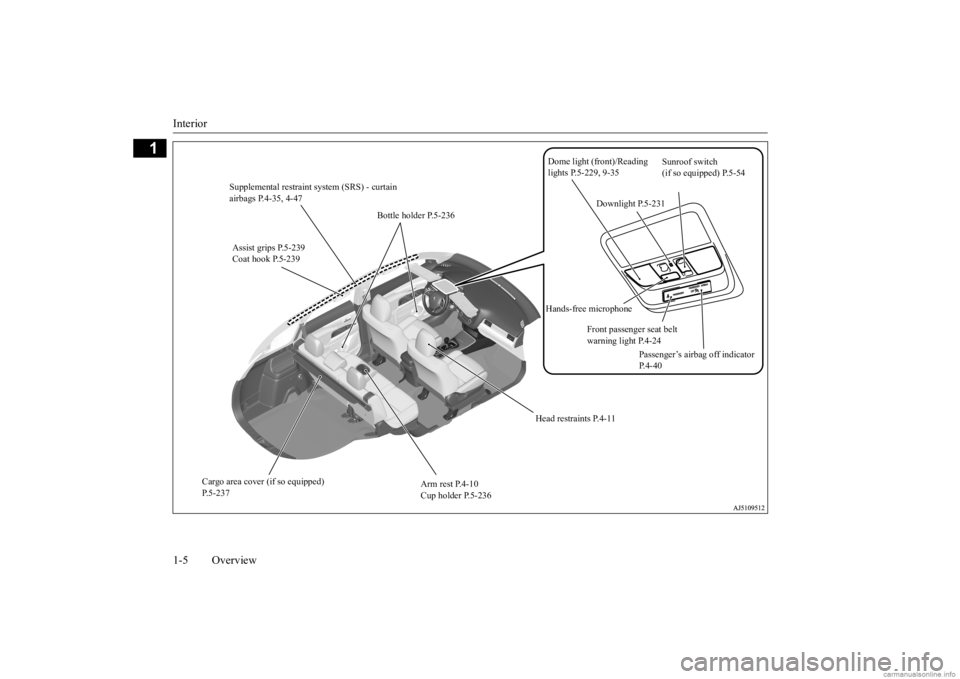
Interior 1-5 Overview
1
Assist grips P.5-239 Coat hook P.5-239
Bottle holder P.5-236
Sunroof switch (if so equipped) P.5-54
Head restraints P.4-11
Arm rest P.4-10 Cup holder P.5-236
Cargo area cover (if so equipped) P.5-237
Supplemental restraint system (SRS) - curtain airbags P.4-35, 4-47
Dome light (front)/Reading lights P.5-229, 9-35
Downlight P.5-231
Hands-free microphone
Front passenger seat belt warning light P.4-24
Passenger’s airbag off indicator P.4-40
BK0278200US.book 5 ページ 2019年4月10日 水曜日 午前10時59分
Page 11 of 443

Outside (Front) 1-7 Overview
1
N00100602968
Outside (Front)
Sunroof (if so equipped) P.5-54
Windshield wipers P.5-210
Engine hood P.9-3
Front fog lights (if so equipped) P.5-209, 9-34, 9-39
Outside rearview mirrors P.5-63 Side turn-signal lights (if so equipped) P.5-208, 9-34, 9-39 Side-view camera (if so equipped) P.5-147 Fuel tank filler P.3-3
Power window P.5-51
Front turn-s
ignal lights
P.5-208, 9-34, 9-38
Front turn signal lights P.5-208, 9-34, 9-38
Headlights, low beam P.5-199, 9-34, 9-36 Parking lights P.5-199, 9-34, 9-38 Daytime running lights P.5-199, 9-34, 9-38
Headlights, low beam P.5-199, 9-34, 9-36 Parking lights P.5-199, 9-34, 9-38 Daytime running lights P.5-199, 9-34, 9-38
Headlights, high beam P.5-199, 9-34, 9-37
Headlights, high beam P.5-199, 9-34, 9-37
Halogen headlights type LED headlights type
Front side-marker lights P.5-199, 9-34, 9-37
Front side-marker lights P.5-199, 9-34, 9-37
Sensor (if so equipped) [for Fo
rward Collision Mitigation System
(FCM), Lane Departure Warning System (LDW) and Automatic high beam system] P. 5-118, 5-137, 5-203 Rain sensor (if so equipped) P.5-210 Front-view camera (if so equipped) P.5-147BK0278200US.book 7 ページ 2019年4月10日 水曜日 午前10時59分
Page 12 of 443
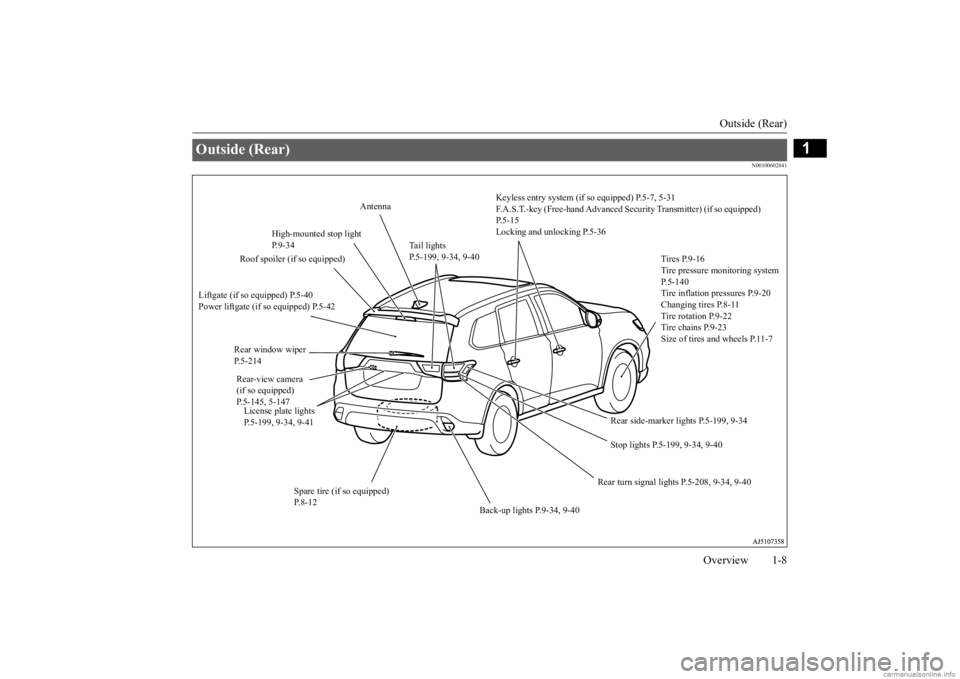
Outside (Rear)
Overview 1-8
1
N00100602841
Outside (Rear)
Keyless entry system (if so equipped) P.5-7, 5-31 F.A.S.T.-key (Free-hand Advanced Se
curity Transmitter) (if so equipped)
P.5-15 Locking and unlocking P.5-36
Tires P.9-16 Tire pressure monitoring system P.5-140Tire inflation pressures P.9-20Changing tires P.8-11 Tire rotation P.9-22 Tire chains P.9-23Size of tires and wheels P.11-7
Stop lights P.5-199, 9-34, 9-40
Rear turn signal lights P.5-208, 9-34, 9-40
Spare tire (if so equipped) P.8-12
Back-up lights P.9-34, 9-40
License plate lights P.5-199, 9-34, 9-41 Rear-view camera (if so equipped) P.5-145, 5-147 Rear window wiper P.5-214
High-mounted stop light P.9-34
Antenna
Liftgate (if so equipped) P.5-40 Power liftgate (if so equipped) P.5-42
Rear side-marker lights P.5-199, 9-34
Tail lights P.5-199, 9-34, 9-40
Roof spoiler (if so equipped)
BK0278200US.book 8 ページ 2019年4月10日 水曜日 午前10時59分
Page 73 of 443
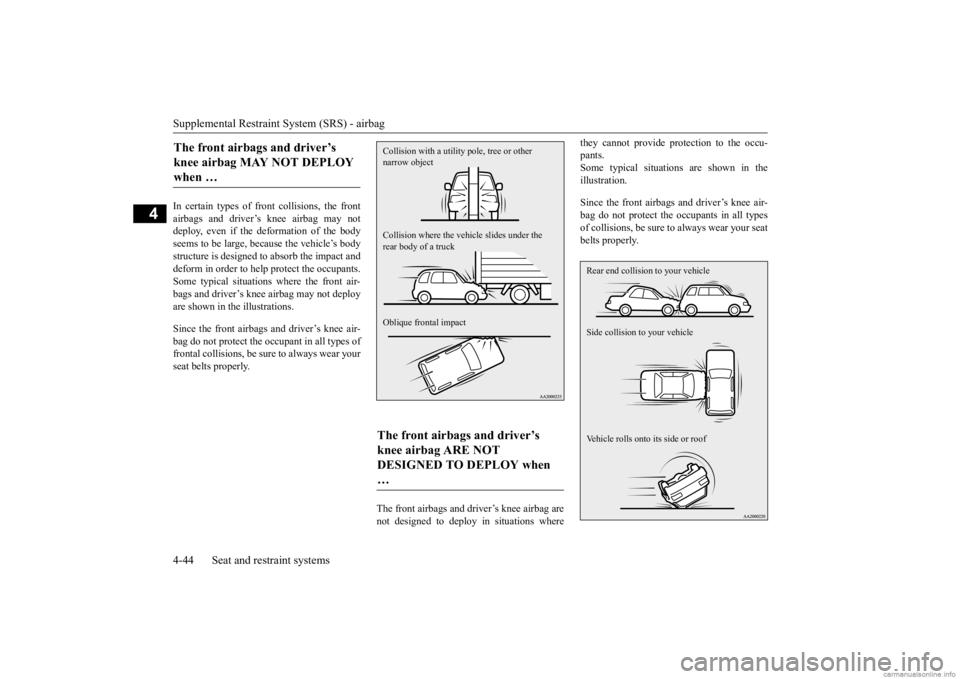
Supplemental Restraint System (SRS) - airbag 4-44 Seat and restraint systems
4
In certain types of front collisions, the front airbags and driver’s knee airbag may notdeploy, even if the deformation of the body seems to be large, because the vehicle’s body structure is designed to
absorb the impact and
deform in order to help
protect the occupants.
Some typical situations where the front air- bags and driver’s knee airbag may not deploy are shown in the illustrations. Since the front airbags and driver’s knee air- bag do not protect the oc
cupant in all types of
frontal collisions, be su
re to always wear your
seat belts properly.
The front airbags and driver’s knee airbag are not designed to deploy in situations where
they cannot provide protection to the occu- pants.Some typical situations are shown in the illustration. Since the front airbags and driver’s knee air- bag do not protect the oc
cupants in all types
of collisions, be sure
to always wear your seat
belts properly.
The front airbags and driver’s knee airbag MAY NOT DEPLOY when …
The front airbags and driver’s knee airbag ARE NOT DESIGNED TO DEPLOY when … Collision with a utility pole, tree or other narrow object Collision where the vehi
cle slides under the
rear body of a truck Oblique frontal impact
Rear end collision to your vehicle Side collision to your vehicle Vehicle rolls onto its side or roof
BK0278200US.book 44 ページ 2019年4月10日 水曜日 午前10時59分
Page 76 of 443
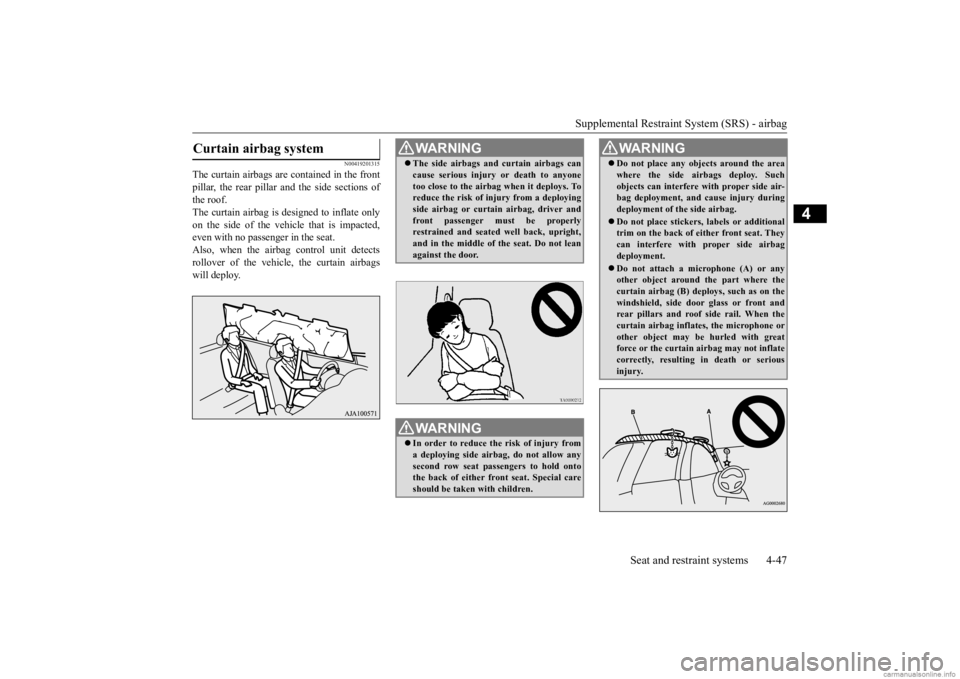
Supplemental Restraint System (SRS) - airbag
Seat and restraint systems 4-47
4
N00419201315
The curtain airbags are contained in the front pillar, the rear pillar and the side sections of the roof.The curtain airbag is designed to inflate only on the side of the ve
hicle that is impacted,
even with no passenger in the seat.Also, when the airbag control unit detects rollover of the vehicle, the curtain airbags will deploy.Curtain airbag system
WA R N I N G The side airbags and
curtain airbags can
cause serious injury
or death to anyone
too close to the airb
ag when it deploys. To
reduce the risk of in
jury from a deploying
side airbag or curtai
n airbag, dr
iver and
front passenger must be properlyrestrained and seated well back, upright, and in the middle of
the seat. Do not lean
against the door.WA R N I N G In order to reduce the risk of injury from a deploying side airb
ag, do not allow any
second row seat passengers to hold onto the back of either front seat. Special careshould be taken with children.
Do not place any objects around the area where the side airbags deploy. Suchobjects can interfere with proper side air-bag deployment, and
cause injury during
deployment of the side airbag. Do not place stickers, labels or additional trim on the back of either front seat. They can interfere with proper side airbagdeployment. Do not attach a microphone (A) or any other object around the part where the curtain airbag (B) depl
oys, such as on the
windshield, side door glass or front andrear pillars and roof
side rail. When the
curtain airbag inflates
, the microphone or
other object may be
hurled with great
force or the curtain airbag may not inflate correctly, resulting in death or serious injury.WA R N I N G
BK0278200US.book 47 ページ 2019年4月10日 水曜日 午前10時59分
Page 78 of 443

Supplemental Restraint System (SRS) - airbag
Seat and restraint systems 4-49
4
The seat belts in your
vehicle are your pri-
mary means of protection in an accident. TheSRS side airbags and curtain airbags are designed to provide
additional protection.
Therefore, for your safety and the safety of alloccupants, be sure to always wear your seat belts properly. In certain types of side
collisions, the side air-
bag and curtain airbag
may not deploy, even
if the deformation of the body seems to belarge, because the vehicle’s body structure is designed to absorb the impact and to deform in order to help protect the occupants. Thereare also cases where the side airbag and cur- tain airbag may not deploy at the same time, depending on the location of the impact.Some typical situations
where the side air-
bags and curtain airb
ags may not deploy are
shown in the illustrations.
Since the side airbags and curtain airbags do not protect the occupant in all types of sidecollisions, be sure to
always wear the seat
belts properly.
The side airbag and curtain airbag are not designed to deploy in situations where theycannot provide protec
tion to the occupants.
Some typical situations are shown in the illustration.
The side airbag and curtain airbag MAY NOT DEPLOY when...
Side impact in an area away from the passenger compartment Motorcycle or other similar small vehicle collision with the side of vehicle Collision with a utility pole, tree or other narrow object
The side airbag and curtain airbag ARE NOT DESIGNED TO DEPLOY when... Oblique side impact Vehicle rolls onto its side or roof (Side airbag only)
BK0278200US.book 49 ページ 2019年4月10日 水曜日 午前10時59分
Page 79 of 443

Supplemental Restraint System (SRS) - airbag 4-50 Seat and restraint systems
4
Since the side airbags and curtain airbags do not protect the occupant
in all types of colli-
sions, be sure to always
wear your seat belts
properly.
N00408500669
Head-on collision Rear end collision to your vehicle Pitch end over end
SRS servicing
WA R N I N G Any maintenance performed on or near the components of the SRS should be per-formed only by an
authorized Mitsubishi
Motors dealer. Do not permit anyone else to do any service, inspection, maintenanceor repair on any SR
S components or wir-
ing. Similarly, no part of the SRS should ever be handled, removed or disposed byanyone except an au
thorized Mitsubishi
Motors dealer. Improper work meth
ods on the SRS com-
ponents or wiring could result in an acci- dental airbag deployment or could make the SRS inoperable. Ei
ther of these situa-
tions could result in serious injury or death. Do not modify your steering wheel or any other SRS component or related vehicle part. For example, replacement of thesteering wheel, or modifications to the front bumper or body structure can adversely affect SR
S performance and
may lead to injury. If your vehicle has received any damage, you should have the
SRS inspected by an
authorized Mitsubishi
Motors dealer to
make sure it is in proper working order.
Do not modify your front seats, center pil- lar or center console. Such modificationscan adversely affect
SRS performance and
may lead to injury. Also, if you discove
r any tear or open
seam in the seat fabr
ic near the side air-
bag, have the seat in
spected by an autho-
rized Mitsubishi Motors dealer. If you have found an
y scratch, crack or
damage to the portion of the front and rear pillars and roof
side rail, you should
have the SRS inspected by an authorized Mitsubishi Motors dealer.NOTE
When you transfer ownership of the vehicle to another person, we
urge you to alert the
new owner that it is
equipped with the SRS
and refer that owner to the applicable sec- tions in this owner’s manual. If you decide to junk or
scrap your vehicle,
we urge you to first take it to an authorized Mitsubishi Motors dealer so that the SRS canbe made safe for disposal. If any of the following parts needs to be modified for use by a handicapped person,the advanced airbag system will be greatly affected. Please consult an authorized Mit- subishi Motors dealer. • Driver’s seat • Front passenger seat • Front seat beltWA R N I N G
BK0278200US.book 50 ページ 2019年4月10日 水曜日 午前10時59分
Page 82 of 443
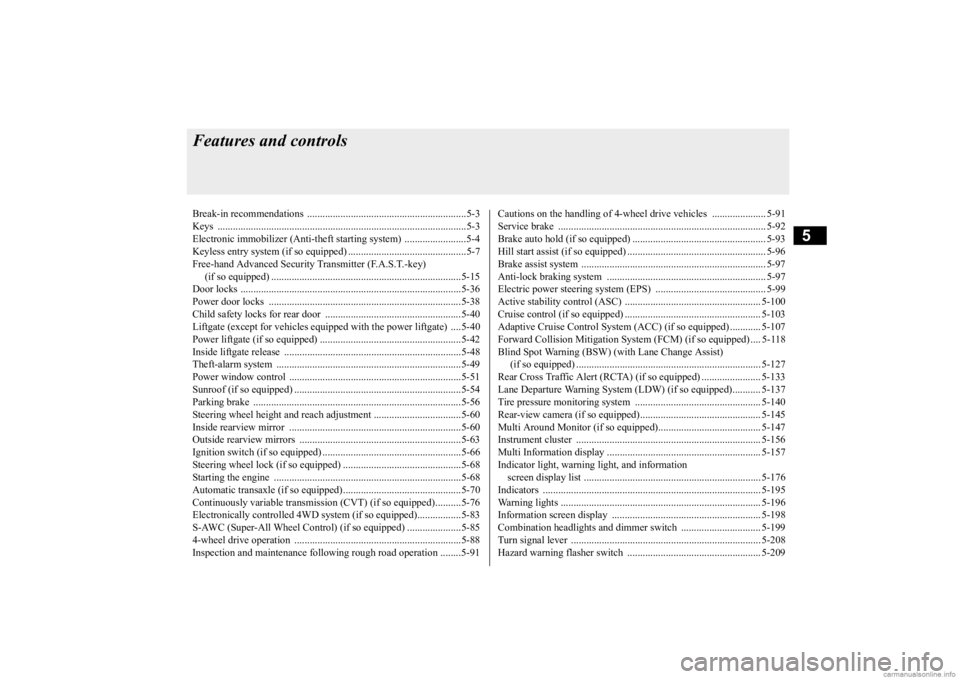
5
Features and controlsBreak-in recommendations ..............................................................5-3 Keys .................................................................................................5-3 Electronic immobilizer (Anti-theft starting system) ........................5-4Keyless entry system (if so equipped) ..............................................5-7 Free-hand Advanced Security
Transmitter (F.A.S.T.-key)
(if so equipped) ..........................................................................5-15Door locks ......................................................................................5-36 Power door locks ......
...........
...........
...........
...........
...........
.........
.....5-38
Child safety locks for rear door ..........
...........
.........
.........
.........
.....5-40
Liftgate (except for vehi
cles equipped with the
power liftgate) ....5-40
Power liftgate (if so equipped) .......................................................5-42 Inside liftgate release .....................................................................5-48Theft-alarm system ........................................................................5-49 Power window control ...................................................................5-51 Sunroof (if so equipped) .................................................................5-54Parking brake .................................................................................5-56 Steering wheel height and reach adjustment ..................................5-60 Inside rearview mirror ...................................................................5-60Outside rearview mirrors ...............................................................5-63 Ignition switch (if so equipped) ......................................................5-66 Steering wheel lock (if so equipped) ..............................................5-68Starting the engine .........................................................................5-68 Automatic transaxle (if so equipped)..............................................5-70 Continuously variable transmission
(CVT) (if so equipped)..........5-76
Electronically controlled
4WD system (if so equipped).................5-83
S-AWC (Super-All Wheel Control) (if
so equipped) .....................5-85
4-wheel drive operation .................................................................5-88Inspection and maintenance followi
ng rough road operation ........5-91
Cautions on the handling of 4-wheel dr
ive vehicles ..................... 5-91
Service brake ................................................................................. 5-92 Brake auto hold (if so equipped) .................................................... 5-93Hill start assist (if so equipped) ...................................................... 5-96 Brake assist system ........................................................................ 5-97 Anti-lock braking system .............................................................. 5-97Electric power steering system (EPS) ........................................... 5-99 Active stability control (ASC) ..................................................... 5-100 Cruise control (if so equipped) ..................................................... 5-103Adaptive Cruise Control System (ACC)
(if so equipped) ............ 5-107
Forward Collision Mitigation System
(FCM) (if so equipped) .... 5-118
Blind Spot Warning (BSW) (w
ith Lane Change Assist)
(if so equipped) ........................................................................ 5-127 Rear Cross Traffic Alert (RCTA) (if so equipped) ....................... 5-133 Lane Departure Warning System (LDW
) (if so equipped)........... 5-137
Tire pressure monitoring system ................................................. 5-140 Rear-view camera (if so equipped)............................................... 5-145 Multi Around Monitor (if so
equipped)..................
...........
........... 5-147
Instrument cluster ........................................................................ 5-156 Multi Information display ............................................................ 5-157 Indicator light, warning light, and information screen display list ..................................................................... 5-176 Indicators ..................................................................................... 5-195 Warning lights .............................................................................. 5-196Information screen display .......................................................... 5-198 Combination headlights and dimmer switch ............................... 5-199 Turn signal lever .......................................................................... 5-208Hazard warning flasher switch .................................................... 5-209
BK0278200US.book 1 ページ 2019年4月10日 水曜日 午前10時59分
Page 135 of 443
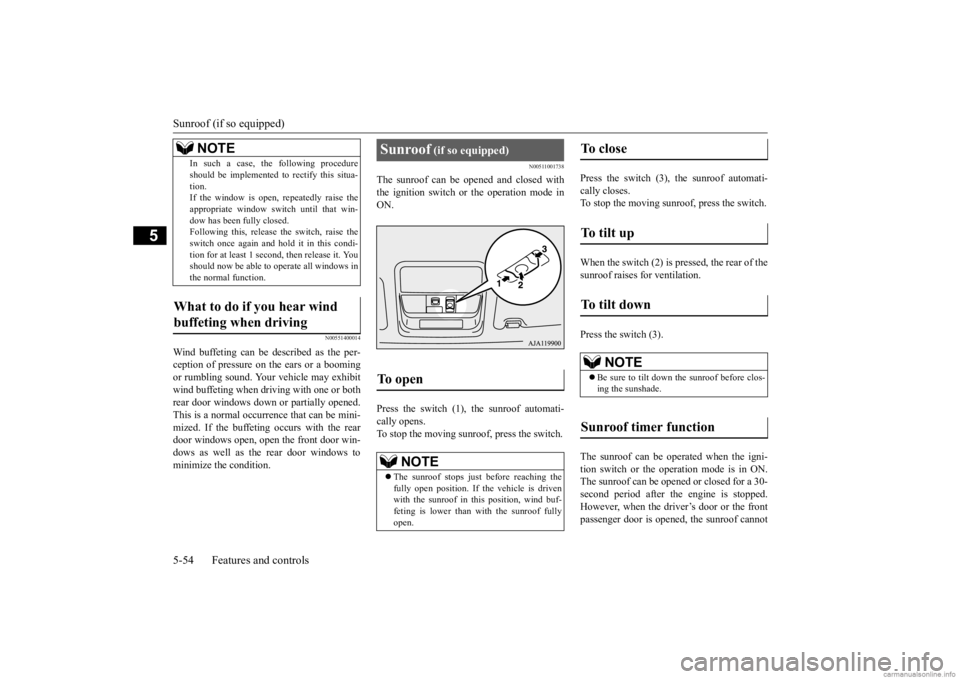
Sunroof (if so equipped) 5-54 Features and controls
5
N00551400014
Wind buffeting can be de
scribed as the per-
ception of pressure on the ears or a boomingor rumbling sound. Your
vehicle may exhibit
wind buffeting when driving with one or both rear door windows down or partially opened.This is a normal occurre
nce that can be mini-
mized. If the buffeting
occurs with the rear
door windows open, open the front door win-dows as well as the rear door windows to minimize the condition.
N00511001738
The sunroof can be opened and closed withthe ignition switch or the operation mode in ON. Press the switch (1), the sunroof automati- cally opens. To stop the moving sunroof, press the switch.
Press the switch (3), the sunroof automati- cally closes. To stop the moving sunroof, press the switch. When the switch (2) is pressed, the rear of the sunroof raises for ventilation. Press the switch (3). The sunroof can be operated when the igni- tion switch or the operation mode is in ON.The sunroof can be opened or closed for a 30- second period after th
e engine is stopped.
However, when the driver’s door or the frontpassenger door is opened, the sunroof cannot
In such a case, the
following procedure
should be implemented to rectify this situa-tion.If the window is open,
repeatedly raise the
appropriate wi
ndow switch until that win-
dow has been fully closed.Following this, release the switch, raise the switch once again and hold it in this condi- tion for at least 1 second, then release it. Youshould now be able to
operate all windows in
the normal function.
What to do if you hear wind buffeting when driving
NOTE
Sunroof
(if so equipped)
To open
NOTE
The sunroof stops just before reaching the fully open position. If the vehicle is drivenwith the sunroof in this position, wind buf- feting is lower than with the sunroof fully open.
To close
To t i l t u p
To t i l t d o w n
NOTE
Be sure to tilt down the sunroof before clos- ing the sunshade.
Sunroof timer function
BK0278200US.book 54 ページ 2019年4月10日 水曜日 午前10時59分
Page 136 of 443
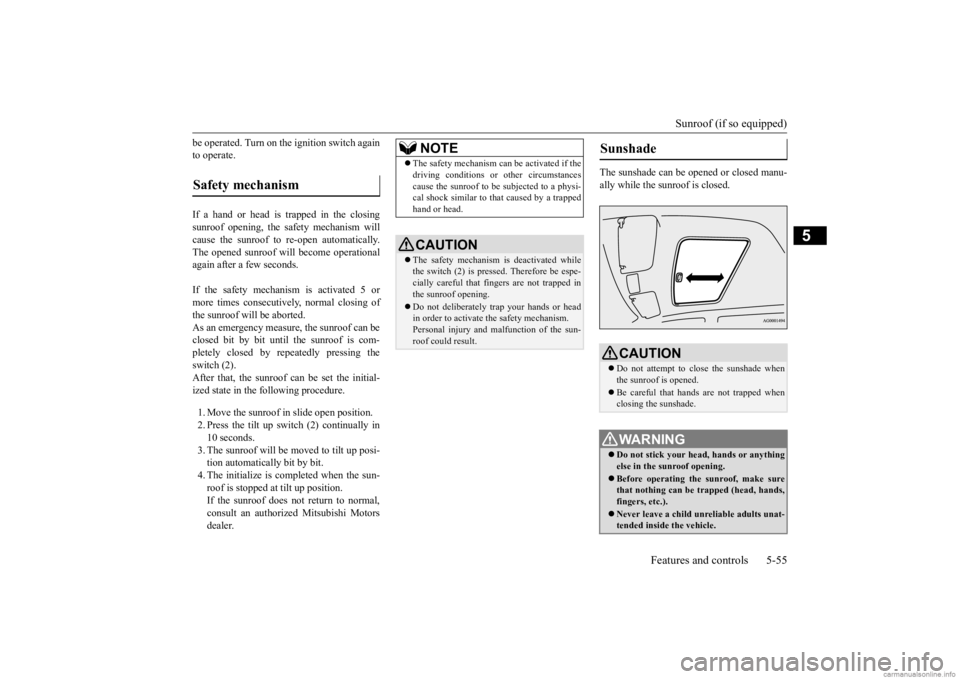
Sunroof (if so equipped)
Features and controls 5-55
5
be operated. Turn on the ignition switch again to operate. If a hand or head is trapped in the closing sunroof opening, the safety mechanism willcause the sunroof to re-open automatically. The opened sunroof will
become operational
again after a few seconds. If the safety mechanism is activated 5 or more times consecutively, normal closing of the sunroof will be aborted. As an emergency measure, the sunroof can beclosed bit by bit until the sunroof is com- pletely closed by re
peatedly pressing the
switch (2).After that, the sunroof can be set the initial- ized state in the following procedure. 1. Move the sunroof in slide open position. 2. Press the tilt up switch (2) continually in10 seconds. 3. The sunroof will be
moved to tilt up posi-
tion automatically bit by bit.4. The initialize is completed when the sun- roof is stopped at
tilt up position.
If the sunroof does not return to normal,consult an authoriz
ed Mitsubishi Motors
dealer.
The sunshade can be opened or closed manu- ally while the sunroof is closed.
Safety mechanism
NOTE
The safety mechanism can be activated if the driving conditions or
other circumstances
cause the sunroof to be
subjected to a physi-
cal shock similar to th
at caused by a trapped
hand or head.CAUTION The safety mechanism is deactivated while the switch (2) is pressed. Therefore be espe-cially careful that fi
ngers are not trapped in
the sunroof opening. Do not deliberately trap your hands or head in order to activate the safety mechanism. Personal injury and malfunction of the sun-roof could result.
Sunshade
CAUTION Do not attempt to close the sunshade when the sunroof is opened. Be careful that hands
are not trapped when
closing the sunshade.WA R N I N G Do not stick your head
, hands or anything
else in the su
nroof opening.
Before operating the sunroof, make sure that nothing can be trapped (head, hands, fingers, etc.). Never leave a child unr
eliable adults unat-
tended inside the vehicle.
BK0278200US.book 55 ページ 2019年4月10日 水曜日 午前10時59分